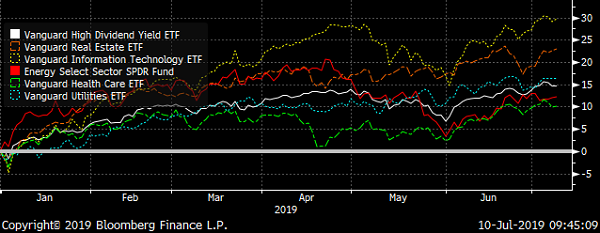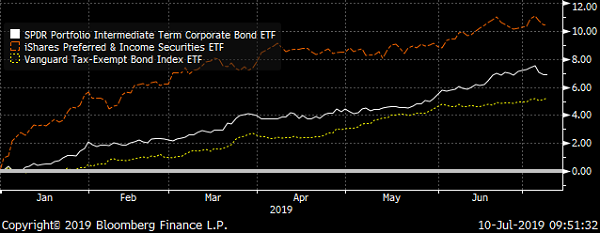9 Set-It-And-Forget-It ETFs To Simplify Your Portfolio

Source: Shutterstock
Sometimes you may need or want a portfolio that can earn you money without a lot of babysitting
Inside my Profitable Investing, I have a large collection of model portfolios which are offered to achieve my goal of all-weather performance with lots of income and risk-controlled growth using stocks, bonds and funds — including ETFs.
For ETFs, your portfolio should be weighted to the best sectors of the U.S. markets, with shares in specific stock sectors that are geared to provide growth and income over time. As such, the stock ETF allocation should be set at 56% of your overall portfolio. I continue to recommend a roughly equal weighing for each of the funds you choose.
This same method applies in the fixed-income sectors that are focused on corporate bonds and preferred stock, as well as the buoyant municipal bond markets. The fixed-income allocation should be set at 44% overall, including an 11% allocation to cash. And like with the stock-based funds, the individual fixed-income ETFs should be weighted evenly.
And note, the municipal bond ETFs can be bought in tax-free accounts. Some brokerages give warnings about this, but there are no restrictions to doing it. You will give up some of the tax-free income advantage, but the total return prospects for this market remain compelling.
Stock Allocations
I’ll start with the Vanguard High Dividend Yield ETF (NYSEARCA:VYM), for access to the general market with a dividend focus. VYM continues to do well year to date with a return of over 14%. Expenses are 0.6%, or just $6 annually for every $10,000 invested.
That is the baseline for the stock market. Now let’s move into one of the more attractive and defensive market sectors. REITs continue to gain from improving property values and rising income, fueling increasing dividends. Step into this sector safely with the Vanguard Real Estate ETF (NYSEARCA:VNQ). This ETF has resulting in a return year to date of 22% and expenses of 0.12%.
Next we move on to the utilities market, which is also gaining from the security of essential services businesses. These, in turn, fuel ample and rising dividends. This sector should be bought with the Vanguard Utilities ETF (NYSEARCA:VPU), which has turned in a return year-to-date of 15.7% and carries expenses of 0.1%.
Healthcare traditionally has been a reliable growth market through thick and thin. Americans continue to need more and more healthcare and related products — again providing security in revenues and reliable dividends. This sector has, though, been affected by concerns over potential government changes in healthcare rules. But these concerns, while valid, are still well into the future, probably well beyond the 2020 election. You can invest here with the Vanguard Health Care ETF (NYSEARCA:VHT), which has generated a return to date of 10.8%. The expense ratio is 0.1%.
Then we move to the technology market. This sector is challenged by the trade negotiations between the U.S. and China, which may further impact supply chains in China as well as sales all over the world. But the innovation engines remain on a fuller throttle, resulting in a return that dwarfs the general stock market. Buy in here with the Vanguard Information Technology ETF (NYSEARCA:VGT) with a return to date of 31.3% and expenses of 0.1%.
The petroleum and energy markets remain uncertain. The supply of crude oil outside the U.S. continues to be threatened by internal hostilities in many Organization of Petroleum Exporting Countries (OPEC) and externally, by sanctions on others including some attacks on ships and pipelines in the Middle East. In the US, shale producers are pumping lots and infrastructure to transport it is coming online — but the stockpiles are holding down prices.
In addition, a slowing global economy is putting supply and demand models into a case for less demand, which is also putting a cap on prices.
All this said, the U.S. companies remain great sources of cash flows and are fueling U.S. regional economic growth. And in turn — they are generating ample cash for bigger dividends. The sector should be represented by the Energy Select Sector SPDR ETF (NYSEARCA:XLE) which has turned in a return year to date of 12.2%.

Stock Sector Performance Year to Date Using Vanguard and SPDR ETFs Source Bloomberg
Fixed-Income ETFs to Invest In
Among fixed-income allocations, you should have specific ETFs for corporate bonds, preferred stocks and municipal bonds.
The U.S. economy continues to grow, with little inflation. This is providing excellent opportunities for specific sectors of the bond markets. Add in a docile Federal Reserve Bank which, while not cutting its target rate range for Fed Funds in the June meeting of its Open Market Committee (FOMC), is still expected to ease money conditions in the target range.
Corporate bonds are doing well. The economy is bringing more revenues to companies, which in turn makes them better credit risks. And with yield above Treasuries, they drive more demand for these bonds. This sector should be bought with the SPDR Portfolio Intermediate Term Corporate Bond ETF (NYSEARCA:SPIB) which has generated a return year to date of 5.5% and a 12-month yield of 3.1%. Expenses are 0.07%.
Next is preferred stocks. Preferred stocks are the bonds of the stock market. They provide the certainty of largely fixed dividends that are paid before dividends to common stockholders. They are defensive and bigger income-producing investments — perfect for the current market. The sector should be bought with the iShares Preferred & Income Securities ETF (NASDAQ:PFF) which has generated a return to date of 8.8% and has a 12-month yield of 5.8%. Expenses are 0.46%.
Municipal bonds continue from last year to be a go-to market for improving prices with yield premiums to U.S. Treasuries. With the economy doing better, tax revenues for most state and local authorities are improving as well, which in turn drives up the credibility and bond prices. The sector should be bought for total return and not just tax-free income with the Vanguard Tax-Exempt Bond ETF (NYSEARCA:VTEB) which has turned in a return to date of 4.1%. Its 12-month yield is 2.3% and expenses are 0.08%.

Fixed Income Sector Year to Date Performance using Index Sector ETFs Source Bloomberg
Neil George is the editor of Profitable Investing and does not have any holdings in the securities mentioned above.
See Also From InvestorPlace:
- The S&P 500’s Best Highest-Yielding Dividend Stocks
- 3 ETFs to Buy That Make Perfect Graduation Gifts
- 6 Stocks to Buy Based on Insider Buying
Category: Sector ETFs




